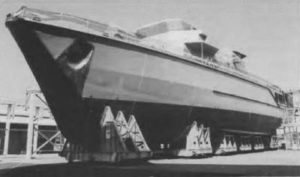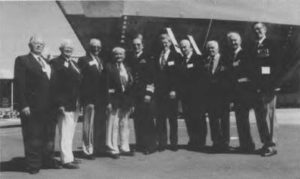- Author
- A.N. Other and NHSA Webmaster
- Subjects
- Ship design and development
- Tags
-
- RAN Ships
- None noted.
- Publication
- March 1997 edition of the Naval Historical Review (all rights reserved)

At the “keel laying” ceremony of H.M.A.S. “Norman”, the third minehunter of the HUON Class, the Chief of Naval Staff, Vice Admiral Rod Taylor AO, pressed a button thus giving the executive order to commence laying the modern fibreglass hull. A large roll of specially designed glass fibre sheeting about one metre wide was hoisted on to a travelling gantry above the mould, the end being paid out and the material being laid up to the sides and bottom of the mould with a purpose built resinous adhesive. This process will be repeated many hundreds of times along the length of the ship, until a hull structure of a single shell with a varying thickness decreasing from the keel to the deck stringer and without any transversal or longitudinal stiffness other than the main bulkheads, is achieved.
This unique Intermarine monocoque design has resulted in the most modern technology fibre composite hull, ideally suited to mine counter-measure vessels.
The Huon class was selected by the Royal Australian Navy after an extensive evaluation of all minehunter designs worldwide, against a very tough specification.
Its capabilities include:
- Design enhanced for operation in tropical conditions
- Fully integrated ship combat and platform system
- Suited to both long transits and precise manoeuvring
- Stable and effective platform
- Low magnetic and acoustic signature
- Unique monocoque hull provides high shock resistance

Left to Right: Eric Young (Norman), Alan Gill (Norman), George Magee (Norman), Stan McAndrew (Napier) VADM Rod Taylor, C.N.S., Mr. Ken Harris G.M., ADI, Bruce Loxton (Norman), Bert Westaway (Norman), Bill Cook (Nizam), Len Delaney (Nepal).
The design authority selected, the Italian company Intermarine SpA, is a world leader in the design of mine counter measure (M.C.M.) vessels of fibre composites. The Huon class is based on the operationally proven Italian `LERICI’ class design. Thirty six vessels based on a similar minehunter platform are in service or on order for five navies. The variants of the design include a number of different sonar/combat systems and engine configurations to meet individual navy requirements. A single propeller, with retractable thrusters for minehunting, is the engine combination chosen by the RAN. The Huon class incorporates a number of enhancements to the `LERICI’ design including an integrated ship system and upgrading the sonar to the variable depth minehunting sonar Type 2093. To improve operations in a tropical environment, the air conditioning system has been upgraded, accommodation improved, and the upper deck extended to provide cover for the mine disposal vehicle and increased boat deck space. The first ship will start sea trials in 1997. With a displacement of 720 tonnes, and a length of 52.5 metres, this third generation minehunter has two separate propulsion systems, one for transiting and minesweeping, and one for minehunting. The transiting system utilises a single controllable pitch propeller driven by a low magnetic, direct injection V8 diesel engine which provides a continuous maximum speed in excess of 14 knots. The minehunting system consists of three retractable auxiliary propulsion units or thrusters, one forward and two aft, driven by hydraulic motors which are electronically controlled to maximise effective thrust while minimising radiated noise. The thrusters have sufficient power to steam the ship at 6 knots continuously. Tanks for liquids (fuel, water, lubricating oil) are made of large longitudinal cylinders connected to watertight bulkheads. Without any direct contact with the ship’s hull they remain clear and isolated when the hull flexes under shock loadings.
- The main engine is suspended in a cradle detached from the hull and connected to the bulkheads, keeping the engine clear when the hull flexes under shock.
- Auxiliary engines are also suspended on cradles and positioned on the main deck to ensure low noise transmissions during minehunting.
- The sonar well, auxiliary propulsion wells, keel and bilge keels are built integrally with the hull.
The Minehunting Sonar
The GEC-Marconi Type 2093 variable depth sonar is deployed through the ship’s sonar trunk.




